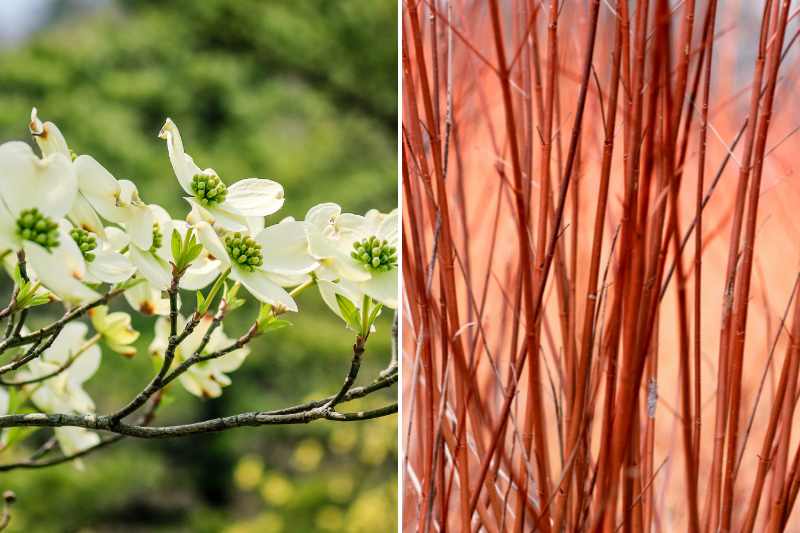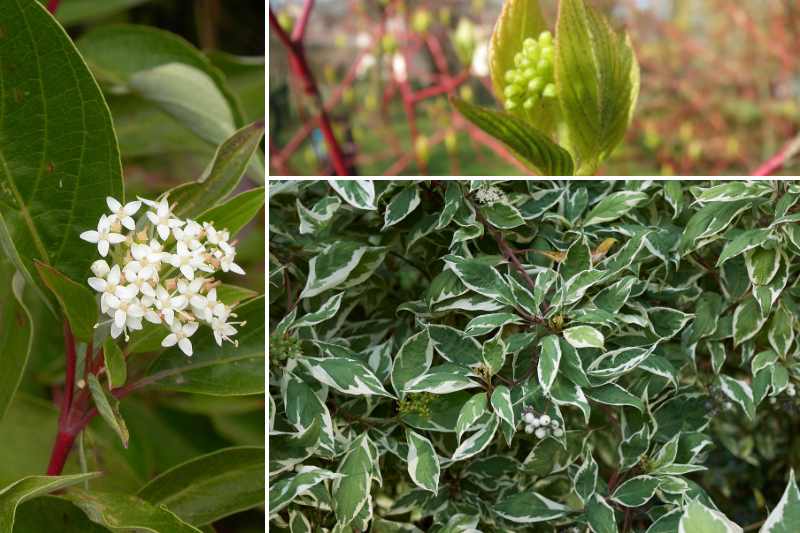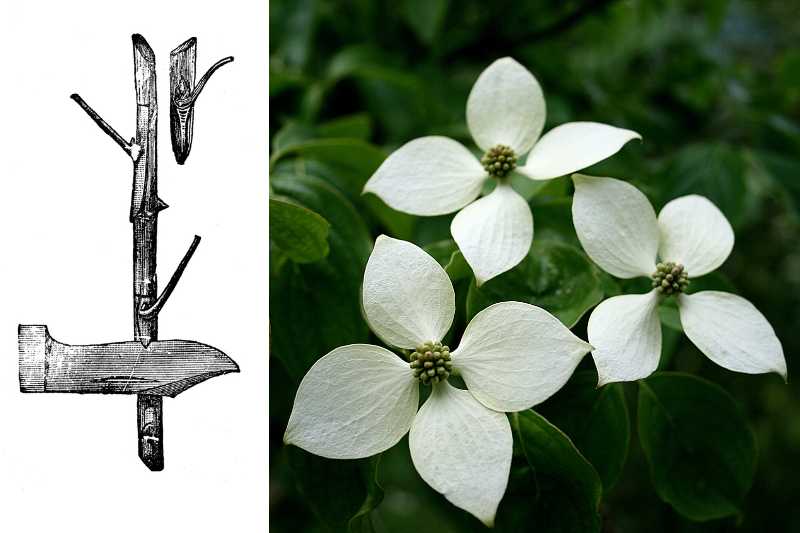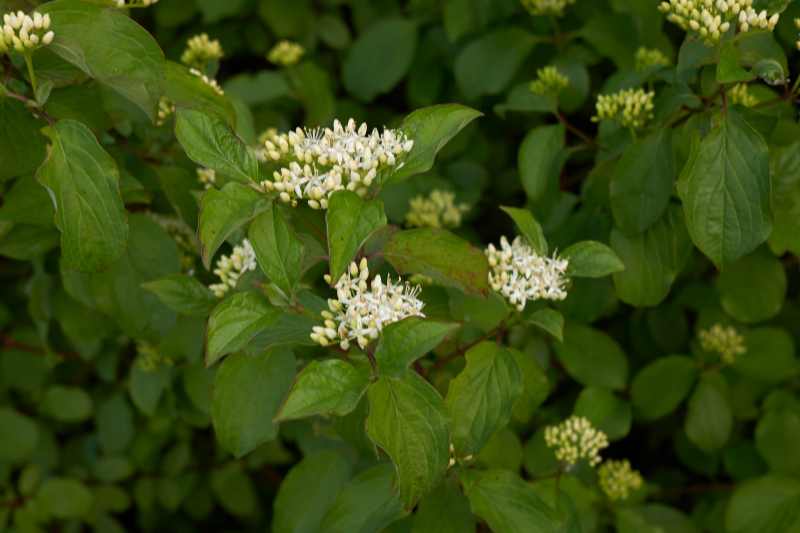The genus Cornus, that is to say dogwoods, is a large botany genus that includes bushes, trees and even a few rare perennials. Depending on dogwood type or species, method of propagation will not be the same. Coloured-wood dogwoods are easy to reproduce by propagation by cuttings or layering, whereas flowering dogwoods will require grafting or sowing, with a lot of patience. How can you easily multiply all these plants? We explain everything in this tutorial.

Flowering dogwoods or coloured-wood dogwoods, they propagate very well!
By sowing
Sowing flowering dogwoods (Cornus kousa, Cornus florida, Cornus nutalii...) can be an option, but you must be patient. Allow several months for germination and sometimes twenty years before the first flowers appear.
- Collect seeds from ripe fruits in October–November;
- Soak them for 24 hours in water;
- Sow in pots in a free-draining growing medium (light seed compost);
- Leave pots in cold frames and do not move them out until following spring;
- Place pots in partial shade and keep compost moist but not waterlogged;
- Pot on individual young plants at four-leaf stage then plant out the following autumn.
Sowing of Cornus controversa and Cornus alternifolia is unpredictable, as few seeds are fertile. Harvest ripe seeds in October, soak for 24 hours then sow in pots in a free-draining medium. Otherwise, sowing technique is identical to that for flowering dogwoods.
Sowing of fruit-bearing dogwoods, such as Cornus mas, is done in March after cold stratification over winter (seeds harvested ripe in autumn). Sow seeds in a light seed compost to 2 cm depth. Keep compost moist but not waterlogged. Germination can take weeks, so be patient. Young plants can be potted on in autumn if well developed.
For coloured-wood dogwoods, sowing is best avoided since propagation by cuttings and layering are so easy. However, sowing technique remains the same if attempted.

Cornus sericea, Cornus sanguinea and Cornus 'Alba Elegantissima'
By cuttings
Coloured-wood dogwoods
Propagation by cuttings is a quick and simple way to obtain many young plants of coloured-wood dogwoods (Cornus alba, Cornus sericea, Cornus sanguinea...) from a single bush. For propagation of Cornus, ideal method remains semi-ripe cutting practised in July–August:
- Take cuttings from lateral shoots that have ripened (i.e. stems in transition from soft to hard wood). At this stage, cuttings root more readily and establish better;
- Insert cuttings into a mix of sand and turf and maintain at 15–18 °C;
- Pot on into a soil/compost mixture as soon as new leaves appear and overwinter away from frost;
- Note that hardwood cuttings taken in November–December also give very good results.
Other dogwoods
It is also possible to take cuttings from flowering dogwoods, pagoda dogwoods (Cornus controversa and Cornus alternifolia) and from fruiting dogwoods (Cornus mas and Cornus officinalis).
However, propagation by cuttings is not recommended for these dogwoods, as success is very uncertain. If you want to try, take 15 cm lengths of semi-ripe stems in August or even September. Remove leaves and side shoots but keep the last two leaves at the tip of the cutting. In a shaded spot, plant cuttings in a mix of garden soil (never chalky) and river sand to lighten it, or in seed compost. Keep cuttings covered to retain humidity.
When roots are sufficient (approximately 2–3 months), carefully pot cuttings into buckets and overwinter them under a cold frame or another place where temperature will not fall below 12 °C. Keep compost moist but not waterlogged throughout cultivation. Successful cuttings can only be planted out in autumn of the following year.
By layering
Layering by trenching is suitable for coloured-wood dogwoods, especially Cornus alba and Cornus sericea, whose low branches often touch the ground and tend to root on contact with soil. Layering consists in inducing roots to form on a portion of stem temporarily buried while still attached to parent plant. In spring or early summer, bury long low branches in a 20 cm deep trench until they root. Separate them in autumn or following spring and grow in pots for a year before planting out.
By grafting
Professional horticulturists use grafting of flowering dogwoods, preferably by shield budding, in July–August. Rootstock can be a Cornus kousa var. Chine sis for Cornus kousa and their hybrids or a Cornus florida of the species type for American flowering Cornus varieties. Rootstock should be a one-year scion.
For propagation of cultivars of Cornus controversa and Cornus alternifolia, shield budding also gives good results but is carried out rather in November.
Shield budding for dogwoods is known as «dormant eye», because shoot emergence will only occur the following spring. How to perform this shield budding:
- A few days before budding, water rootstock generously so bark can lift easily;
- At time of budding or a few days before, choose a well-ripened current-season shoot (hard and brown) with good eyes (wood buds) from variety you wish to multiply. Shoot chosen should be pencil-thick;
- Cut off the lamina of all leaves immediately while keeping the petiole to prevent dehydration of buds;
- Soak base of selected shoot in a glass of water for a few hours before grafting;
- Choose a well-formed eye on scion, preferably at centre of shoot, in the axil of a leaf or at a leaf scar. With a grafting knife, make cuts about 1.5 cm below and above the eye, then slide blade of knife under bark, from top to bottom, without going too deep into the wood;
- Once shield is taken, turn it over and remove any tongue of wood if necessary with spatula of grafting knife;
- On a cleared area of a rootstock shoot, make a shallow T-cut (to cambium). Gently peel back bark on both sides with spatula of grafting knife;
- Slide shield into notch then trim horizontally the upper part protruding from T so that bark edges of scion and rootstock are well applied one against the other;
- Tie up graft with vittae or wet raffia so tissues are firmly applied to each other, but do not cover the bud;
- If graft is successful, petiole left on scion falls off after about 15 days;
- Remove binding only once scion has grown at least 5 to 10 cm;
- Wait until scion shoot reaches 30 cm in spring before cutting back rootstock to 15 cm above graft point, then tie the shoot to that stub.

Grafting is recommended for flowering dogwoods
By recovery of suckers or natural seedlings
Some dogwoods, such as Cornus sanguinea or common dogwood, produce many suckers. This is an opportunity to obtain a free young plant. Separate sucker from parent with a sharp spade and transplant young plant elsewhere in spring, or better, in autumn.
Some non-hybrid flowering dogwoods can, if conditions allow, self-seed beneath trees. Again, simply lift the young plant and transfer it elsewhere in ground or keep in a pot for a year before final planting. Operation is best carried out in autumn.

Cornus sanguinea































![[plant id="1234" quantity="5"] [plant id="123" quantity="multiply"]](https://en.promessedefleurs.eu/blogwp/wp-content/uploads/2022/12/multiplier-les-cornouillers.jpg)
Comments